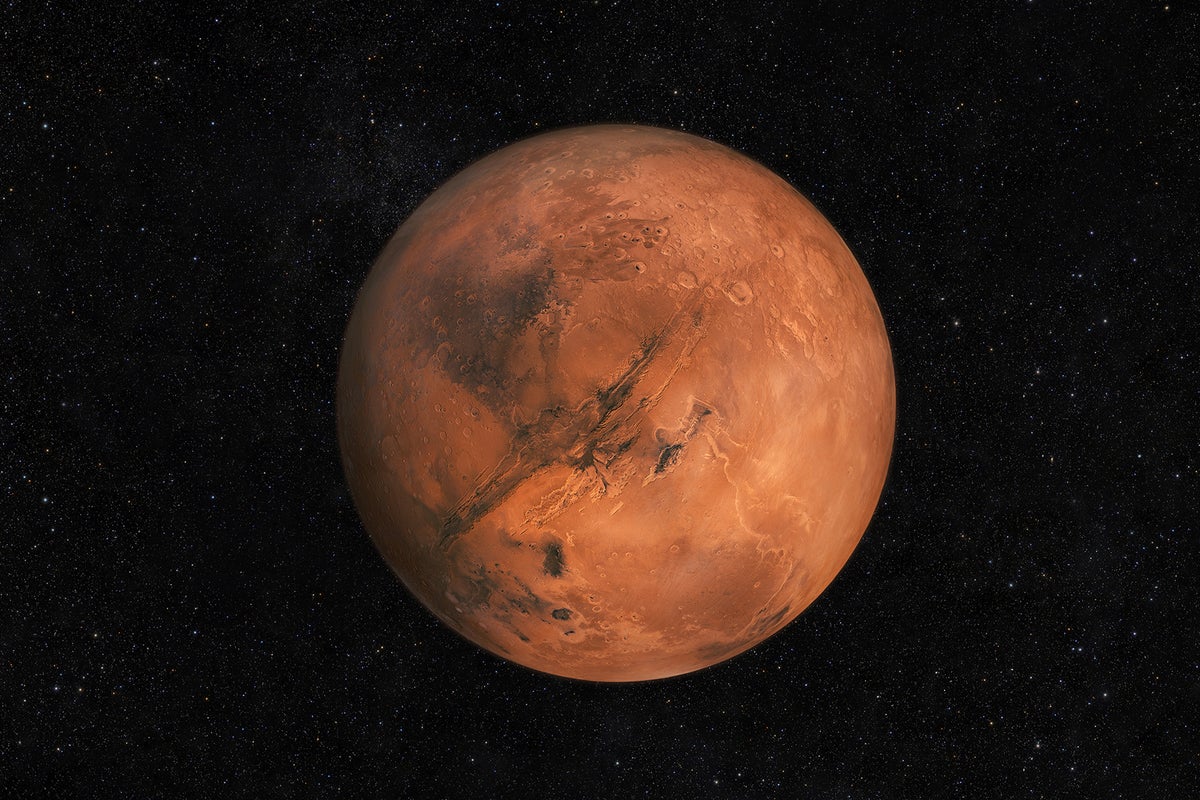
Happy Martian New Year! | Scientific American
You may think it’s a few weeks early to celebrate the new year, but that’s only because you’re Earthist: November 12, 2024, marks the new year for Mars, when the calendar turns the page from 37 to 38.
And here I am, still putting 37 on all my checks.
Why would anyone pick November 12 as New Year’s Day for Mars? And why does our official reckoning of Martian time set the eons-old Red Planet only in its 38th year? The answer involves a combination of natural cycles and the human need to impose order via somewhat arbitrary timekeeping—pretty much like on Earth.
On supporting science journalism
If you’re enjoying this article, consider supporting our award-winning journalism by subscribing. By purchasing a subscription you are helping to ensure the future of impactful stories about the discoveries and ideas shaping our world today.
Here on our home planet, most countries use the Gregorian calendar to keep track of the year. This was first adopted in 1582 (although it took quite some time to spread around the world) and is your standard 12-month calendar—365 days every year, with a bonus day added on every fourth year (a “leap” year). The Gregorian calendar starts on January 1 as a holdover from its predecessor, the Roman Empire’s Julian calendar; to honor the god Janus, Julius Caesar proclaimed that day to be the year’s first.
As an astronomer, I might wish we marked the first day of the year using a date of some astronomical significance. The problem there is Earth stubbornly refuses to play nice with any sort of organized calendar. For example, our planet’s path around the sun is an ellipse, or oval shape. That means there is a point in time when it gets closest to the sun, which we call perihelion. That seems like a natural date for the start of a new year.
But Earth’s orbital shape changes subtly every year because of the gravitational influence of the other planets, altering the exact time of perihelion. Another tweak to perihelion’s timing comes from Earth’s moon, which tugs on our planet to make it wobble a bit as we co-orbit the sun. These make perihelion an unworkably complicated way to start a calendar, even though perihelion also happens to occur in January. (Aphelion—when Earth is farthest from the sun—occurs in July.)
If you know a little bit more about astronomy, you might try to tag the new year with the equinoxes or solstices. These dates are based on Earth’s axial tilt, our planet’s roughly 23-degree pitch relative to the plane of its orbit (which is why you always see classroom globes tilted over on their stand). The June solstice, for example, occurs when the planet’s north pole is tipped most toward the sun, which happens on or about the 21st of that month every year. (Note that this is in winter for people in the Southern Hemisphere, which is why astronomers tend to shy away from calling it the “summer solstice.”)
Astronomers prefer to measure everything in the sky relative to the March equinox, also called the vernal (“relating to spring”) equinox as a holdover from Northern Hemisphere–focused timekeeping. There are many ways to think about the March equinox, but astronomers think of it as the time when the sun’s position on the sky crosses the celestial equator, the projection of Earth’s equator onto the sky. That’s a handy point in time and space to use for measuring things like the positions of the planets and stars.
But again, because of the changing shape of Earth’s orbit, using that to mark the new year would be a hassle. The calendar date changes every year, adding unwieldy layers of chronological complexity.
So what does all this have to do with Mars?
Early in the 20th century, as humans began scrutinizing Mars with more powerful telescopes, we saw global changes sweep across that planet in sync with its changing position in its orbit. Then, as exquisite in situ observations emerged from our probes sent to the Red Planet, it became clear we needed some sort of Mars calendar.
Such a calendar would have to be very different from ours. The most obvious reason is that Mars is farther out from the sun and takes almost two Earth years to complete a single orbit around our star; a Martian year is about 687 Earth days!
A Mars day—called a sol, to distinguish it from an Earth day—is also a little bit longer than our terrestrial one, lasting 24 hours, 39 minutes and 35 seconds. There are about 668 sols in a Martian year.
But these differences are actually liberating because they free us from our historic legacy of arbitrary sociopolitical machinations. At Mars, we were able to get a fresh start, defining when we wanted the year to begin essentially from scratch.
So planetary scientists decided to start the Martian new year at the time of the planet’s vernal equinox. Like Earth, the spin axis of Mars is tipped over relative to its orbit, and Mars even has a relatively Earth-like axial tilt of about 25 degrees. That means it has seasons similar to ours, creating the global changes earlier astronomers had witnessed. As temperatures rise in the Martian spring, dust storms arise, and some grow so large they can cover much of the planet. The onset of summer in a given hemisphere heats the respective polar ice cap, which shrinks in size as it sublimates (turns from solid to gas).
Why not use the equinox as a starting date, then? If we have to choose a date, that one makes as much sense as any.
If only things could be so simple. Earth’s orbit around the sun is very nearly a circle, and the seasons all last about three months. But Mars’s orbit around the sun is decidedly elliptical. When the planet is closest to the sun (in winter in its northern hemisphere) its orbital speed is faster than when it’s furthest (in northern summer), and combined with the oval orbital shape, this means the seasons have significantly different lengths. Northern spring is 194 sols long, while summer is 178, autumn is 142 and winter is 154 sols in duration.
These odd seasons would make living on Mars weird. I mean, it would of course be hard: the suffocatingly thin atmosphere, high radiation levels, lack of quick and easy access to supplies from Earth, and so on would all make it extremely difficult to eke out a life there. But the wonky calendar would be a constant source of extra irritation.
And what of the year number—the bizarre fact that our Martian calendar has so far only advanced to Year 38? Scientists decided to mark Year 1 as the time a huge dust storm raged across the planet’s surface in 1956—one of the most notable events on another planet during the early space age. The vernal equinox for that Martian year occurred on April 11, 1955, so that’s now accepted as the planet’s first New Year’s Day. To make things less ambiguous, scientists also defined Year 0 as starting on the previous equinox, May 24, 1953. This prevents any weirdness like that of the Gregorian calendar, which, because it has no Year 0, creates strange situations such as new centuries starting on years ending with 01 instead of 00. (The 21st century, for instance, began on January 1, 2001.)
Put this all together, and you’ll see that Year 38 on Mars begins on November 12, 2024, in the earthly Gregorian calendar, at around 16:00 coordinated universal time, or UTC (11 A.M. EST). Get your party hats and champagne ready!
And don’t forget: when the clock ticks down to zero, it’s time to sing Ares Lang Syne.
Source link


